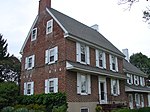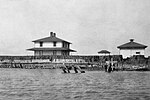Fort Nya Elfsborg
1643 establishments in the Swedish colonial empireColonial forts in New JerseyFinnish-American culture in New JerseyFinnish-American historyFormer populated places in New Jersey ... and 7 more
Forts of New NetherlandForts of New SwedenNew NetherlandNew SwedenSalem County, New JerseySwedish-American historySwedish American culture in New Jersey

Fort Nya Elfsborg was a fortification and settlement established as a part of New Sweden. Built in 1643 and named after the Älvsborg Fortress off Gothenburg, Fort Nya Elfsborg was located on the New Jersey side of the Delaware River, between present day Salem and Alloway Creek.
Excerpt from the Wikipedia article Fort Nya Elfsborg (License: CC BY-SA 3.0, Authors, Images).Fort Nya Elfsborg
River Lane, Elsinboro Township
Geographical coordinates (GPS) Address Nearby Places Show on map
Geographical coordinates (GPS)
| Latitude | Longitude |
|---|---|
| N 39.548333333333 ° | E -75.525555555556 ° |
Address
River Lane 152
08079 Elsinboro Township
New Jersey, United States
Open on Google Maps








